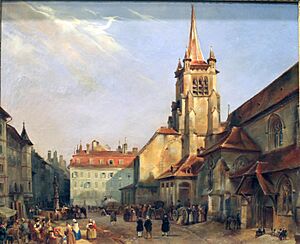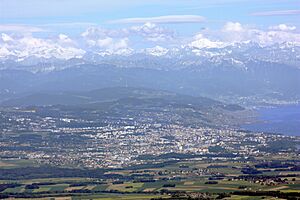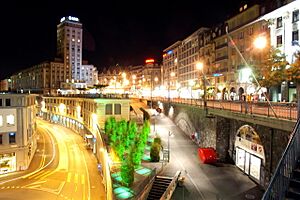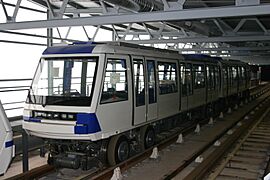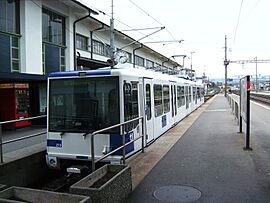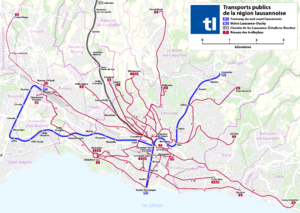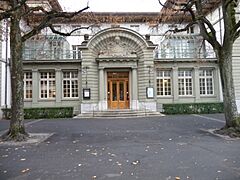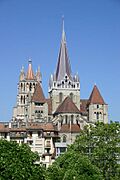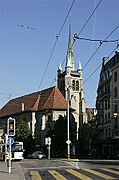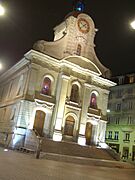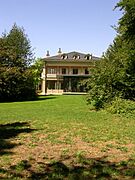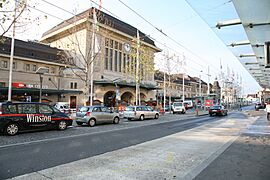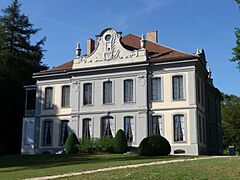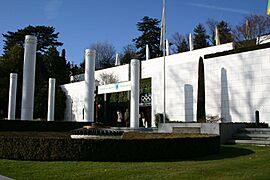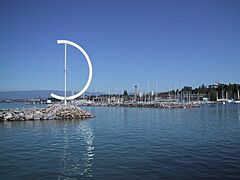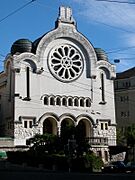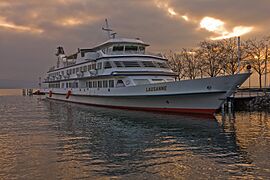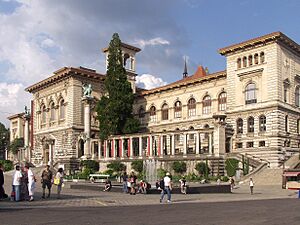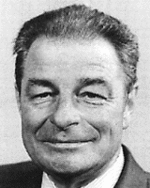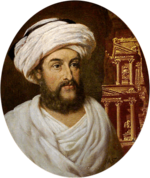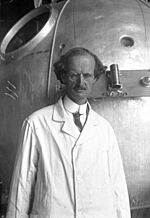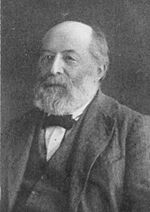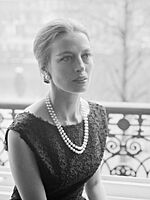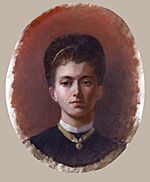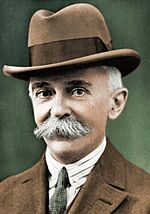Lausanne facts for kids
Quick facts for kids
Lausanne
|
|||
|---|---|---|---|
|
Municipality
|
|||
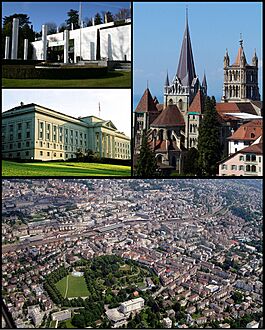
From top to bottom; left to right: the Olympic Museum, the Cathedral of Lausanne, the Federal courts of Switzerland, aerial view of the city, and the park of Milan.
|
|||
|
|||
| Country | Switzerland | ||
| Canton | Vaud | ||
| District | Lausanne | ||
| Area
Lua error in Module:Wd at line 1575: attempt to index field 'wikibase' (a nil value).
|
|||
| • Total | Lua error in Module:Wd at line 1,575: attempt to index field 'wikibase' (a nil value). km2 (Formatting error: invalid input when rounding sq mi) | ||
| Elevation
(Cité)
|
526 m (1,726 ft) | ||
| Highest elevation
(Montagne du Château)
|
935 m (3,068 ft) | ||
| Lowest elevation | 372 m (1,220 ft) | ||
| Population
(2018-12-31)Lua error in Module:Wd at line 1575: attempt to index field 'wikibase' (a nil value).
|
|||
| • Total | Lua error in Module:Wd at line 1,575: attempt to index field 'wikibase' (a nil value). | ||
| Demonym(s) | French: Lausannois(e) | ||
| Time zone | UTC+01:00 (Central European Time) | ||
| • Summer (DST) | UTC+02:00 (Central European Summer Time) | ||
| Postal code(s) |
1000 (in general), 1003–1007, 1010–1012, 1000 Lausanne 25–27, 1052 Le Mont-sur-Lausanne (partly), 1053 Cugy VD (partly), 1032 Crissier (partly), 1032 Romanel-sur-Lausanne (partly), 1033 Cheseaux-sur-Lausanne (partly)
|
||
| SFOS number | Lua error in Module:Wd at line 1575: attempt to index field 'wikibase' (a nil value). | ||
| Localities | Le Chalet-à-Gobet, Montblesson, Montheron, Ouchy, Vernand-Dessous, Vernand-Dessus, Vers-chez-les-Blanc | ||
| Surrounded by | Bottens, Bretigny-sur-Morrens, Chavannes-près-Renens, Cheseaux-sur-Lausanne, Crissier, Cugy, Écublens, Épalinges, Évian-les-Bains (FR-74), Froideville, Jouxtens-Mézery, Le Mont-sur-Lausanne, Lugrin (FR-74), Maxilly-sur-Léman (FR-74), Montpreveyres, Morrens, Neuvecelle (FR-74), Prilly, Pully, Renens, Romanel-sur-Lausanne, Saint-Sulpice, Savigny | ||
| Website | Lua error in Module:Wd at line 1575: attempt to index field 'wikibase' (a nil value). Profile , SFSO statistics |
||
Lausanne is a major city in Switzerland. It is the capital of the canton of Vaud, where people speak French. Lausanne is a hilly city located on the shores of Lac Léman, also known as Lake Geneva. It sits between the Jura Mountains and the Alps, directly across the lake from the French town of Évian-les-Bains. Lausanne is about 62 kilometers (38 miles) northeast of Geneva.
The city of Lausanne has a population of around 140,000 people. This makes it the fourth largest city in Switzerland, after Basel, Geneva, and Zurich. If you include the surrounding areas, the population grows to about 420,000. The larger area around Lake Geneva, called Arc lémanique, has over 1.3 million people and is growing fast.
Lausanne started as a settlement for the Celts and Romans by the lake. It later grew into a town around the Notre Dame Cathedral, which was built in the 12th century. Today, Lausanne is known as the "Olympic Capital" because it hosts the International Olympic Committee. It is also home to the Court of Arbitration for Sport and many international sports groups. The city is famous for its wine-growing regions and has a metro system with 28 stations, making it the smallest city in the world with a rapid transit system. Lausanne also hosted the 2020 Winter Youth Olympics.
Contents
History of Lausanne
The Romans built a military camp called Lousanna near the lake, where Vidy and Ouchy are today. On a hill above, there was a fort called Lausodunon. By the 4th century AD, it was known as civitas Lausanna.
After the Western Roman Empire fell, people moved to the current city center. This hilly spot was easier to defend. The city was then ruled by the Counts of Savoy and the Bishop of Lausanne.
From 888 to 1032, Lausanne was part of the kingdom of Upper Burgundy. In the 11th century, it became an important center for politics, business, and religion. The city grew a lot in the 12th and 13th centuries. In 1275, the Lausanne Cathedral was officially opened with important leaders present.
Later, in 1536, forces from the canton of Bern took over Lausanne. They ruled until 1798. The Bernese changed the Lausanne Cathedral, removing many of its Roman Catholic items. Some valuable treasures, like tapestries, were taken and never returned, despite Lausanne's requests.
After the Edict of Nantes was cancelled in 1685, Lausanne became a safe place for French Huguenots, who were Protestants. A seminary was opened in 1729 to train pastors. During the Napoleonic Wars, Lausanne's status changed. In 1803, it became the capital of a new Swiss canton of Vaud and joined the Swiss Federation.
Modern Times and Important Events
In 1923, a very important agreement called the Treaty of Lausanne was signed in the city. This treaty helped create the modern country of Turkey. In 1964, Lausanne hosted the Swiss National Exhibition, which showed the city's ability to host big international events.
From the 1950s to the 1970s, many people from Italy, Spain, and Portugal moved to Lausanne. They mostly settled in the industrial area of Renens.
Lausanne has also been a popular place for artists and writers. Famous people like T. S. Eliot, Ernest Hemingway, Edward Gibbon, Percy Bysshe Shelley, and Lord Byron have spent time or lived here.
In June 2022, Lausanne opened Plateforme 10, a new art district. It includes three museums: the Cantonal Museum of Fine Arts (MCBA), Photo Elysée, and the Museum of Contemporary Design and Applied Arts (MUDAC).
Geography of Lausanne
Lausanne's Landscape
The most important natural feature near Lausanne is Lake Geneva (called Le Léman in French). Lausanne is built on the side of the Swiss plateau, which means it's quite hilly. There's a big difference in height, about 500 meters (1,640 feet), between the lakeshore at Ouchy and the northern parts of the city. From Lausanne, you can see amazing views of the lake and the Swiss and Savoyan Alps.
The center of Lausanne has a hidden river called the Flon. This river was covered up in the 1800s. It forms a valley that runs through the middle of the city, south of the old town. Several bridges cross this valley to connect different neighborhoods. Because of these big height differences, it's good to know where you are going in Lausanne, so you don't end up on a street far above or below your destination! The main metro station in this valley is also called Flon.
The city area includes several villages like Vidy, Cour, Ouchy, and Montblesson. Lausanne is also located where two large wine-growing regions, Lavaux and la Côte, meet.
Lausanne covers about 41.38 square kilometers (15.98 square miles). About 15% of this land is used for farming, and 38.8% is covered by forests. Most of the rest (45.9%) is developed with buildings and roads.
Lausanne's Weather
Lausanne usually has about 120 days of rain or snow each year. On average, it gets about 1,153 millimeters (45.4 inches) of rain. May is the wettest month, with about 117 millimeters (4.6 inches) of rain over 12 days. February is the driest month, with about 67 millimeters (2.6 inches) of rain over 9 days.
People of Lausanne
Population and Languages
Lausanne has a population of about 141,000 people. As of 2013, about 42% of the people living in Lausanne were from other countries. Over the past ten years, the city's population has grown by about 9.9%. Most people in Lausanne speak French, which is spoken by about 78.8% of the population. German is the second most common language, followed by Italian.
The city has a diverse population. In 2008, more people moved into Lausanne than moved out, especially non-Swiss citizens. This helped the city's population grow.
Lausanne has a mix of age groups. About 9.4% of the population are children under 9 years old, and 9.7% are teenagers between 10 and 19. A large part of the population, about 16.8%, is between 20 and 29 years old.
Homes in Lausanne
In 2000, there were over 62,000 homes in Lausanne. On average, there were about 1.9 people living in each home. Many homes (about half) were lived in by just one person. There were also many married couples, with and without children, and single parents.
Most of the buildings in Lausanne are multi-family buildings, meaning they have many apartments. There are also single-family homes and buildings used for both homes and businesses. Most apartments in the city have three rooms. The majority of apartments are lived in all year round.
Transportation in Lausanne
Lausanne has a great public transport system that connects the city locally, nationally, and internationally. You can catch national and international trains from Lausanne railway station. This station is also a main stop for the local RER Vaud train system and the city's metro.
The metro and local buses are run by a company called TL (Transports publics de la région lausannoise). Many bus routes use trolleybuses, which are electric buses that get power from overhead lines. There are also more local trains run by the Lausanne–Echallens–Bercher railway (LEB) from Lausanne-Flon station. If you want to travel across Lake Geneva, you can take a ship from the Compagnie Générale de Navigation sur le lac Léman (CGN).
Lausanne was the first city in Switzerland to have a rubber-tyred metro system, which is a type of metro where the trains run on rubber tires instead of steel wheels. The m2 Line opened in October 2008. There are plans to make the metro system even bigger and to bring back trams.
Lausanne is also connected to major highways, the A1 and A9 motorways, which link it to other big cities like Geneva and Zurich, and to France and Italy.
The small Lausanne Airport is located at Blécherette. You can also easily get to Geneva International Airport by train, which takes about 42 minutes.
Economy of Lausanne
Lausanne has a strong economy. In 2010, the unemployment rate was 8%. Many people work in the service sector, which includes jobs in sales, transport, hotels, finance, education, and healthcare. There are also jobs in manufacturing and construction.
Many people who work in Lausanne travel into the city from other towns. About 40.9% of workers use public transportation to get to work, and 35.1% use a private car.
Several large companies have their main offices in Lausanne or nearby. These include:
- Banque cantonale vaudoise (banking)
- Logitech (computer parts)
- Nespresso (coffee, part of Nestlé)
- Philip Morris International (tobacco)
- Tetra Laval (packaging)
Education in Lausanne

Lausanne is a hub for education. About 32.1% of the people in Lausanne have finished high school, and 18.4% have gone on to higher education at a university or college.
In the 2009/2010 school year, there were over 12,000 students in Lausanne's schools. The local school system offers two years of optional pre-school. Primary school lasts for four years, and middle school (lower secondary) lasts for six years.
Lausanne has many museums that are great for learning:
- The Collection de l'art brut (Outsider Art)
- The Fondation de l'Hermitage (Art Museum)
- The Musée cantonal d'archéologie et d'histoire (Archaeology and History Museum)
- The Musée cantonal de géologie (Geology Museum)
- The Musée cantonal de zoologie (Zoology Museum)
- The Cantonal Museum of Fine Arts
- The Museum of Contemporary Design and Applied Arts (MUDAC)
- The Musée de l'Élysée (Photography Museum)
- The Musée historique de Lausanne (History Museum)
Libraries and Higher Education
Lausanne has several large libraries, including the Cantonal and University Library of Lausanne and the library of the Swiss Federal Institute of Technology in Lausanne (EPFL). These libraries hold millions of books and other media.
The city is home to several world-class universities and research centers, attracting students from all over the world:
- Swiss Federal Institute of Technology in Lausanne (EPFL)
- University of Lausanne (UNIL)
- University Hospital of Lausanne (CHUV)
- École hôtelière de Lausanne (EHL) (Hotel Management School)
- École cantonale d'art de Lausanne (ECAL) (Art School)
- International Institute for Management Development (IMD)
There are also several international and private schools in Lausanne, such as the International School of Lausanne and Collège Champittet.
Culture and Arts in Lausanne
Important Buildings and Sites
Lausanne has 46 buildings or sites that are considered very important national heritage sites. The entire old city of Lausanne is also a protected heritage site.
Some of these important places include:
- Religious Buildings: Notre-Dame Cathedral, the Swiss Reformed Churches of Saint-François and Saint-Laurent, and the Synagogue.
- Civic Structures: St-Maire Castle, Railway station, Beau-Rivage Palace hotel, City Hall, and the Olympic Museum.
- Museums and Libraries: The Lausanne Museum of History, Beaulieu Castle (home to the Collection de l'art brut), Musée de l'Élysée, Museum of Contemporary Design and Applied Arts (MUDAC), and the Palais de Rumine which houses several museums.
- Archaeological Sites: The Roman-era city on the hill and the prehistoric and Roman settlement of Vidy.
-
Olympic Museum and Archives of the International Olympic Committee
Cultural Life
Lausanne has a lively music scene with groups like the Orchestre de chambre de Lausanne (Chamber Orchestra) and the Lausanne Opera.
Every January, the city hosts the Prix de Lausanne, a famous dance competition. Dancers and dance experts from all over the world come to this event at the Palais de Beaulieu, which is the biggest theater in Switzerland.
The Swiss Film Archive is located in Lausanne. The city also hosts film festivals, such as the Festival cinémas d’Afrique Lausanne. The "Capitole" cinema, which opened in 1929, is the largest cinema in Switzerland.
Lausanne hosted the Eurovision Song Contest 1989. In July, the Festival de la cité takes place in the old town. Other music festivals include the Bach Festival.
Lausanne is also home to the famous Béjart Ballet.
Sports in Lausanne
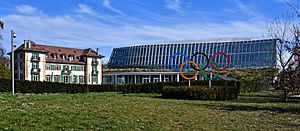
Lausanne is known as the "Olympic Capital" because it is home to the International Olympic Committee (IOC). Many other international sports organizations also have their headquarters here, including the Court of Arbitration for Sport (CAS).
With Lake Geneva nearby, water sports are popular. The surrounding mountains are great for mountaineering. Cycling is also a common hobby, with challenging routes and beautiful views through the vineyards.
Lausanne hosts several sports events throughout the year:
- Athletissima: an annual Track and field meeting.
- 20 km of Lausanne: a road running race through the city.
- Tour de Romandie: a road cycling race.
- Marathon of Lausanne and triathlon competitions.
The two most popular sports in Lausanne are ice hockey and football. Lausanne hosted the 2020 Winter Youth Olympics and was a host city for the 2020 IIHF World Championship.
Local Sports Teams
- Lausanne HC: Ice Hockey Club
- Lausanne-Sport: Football Club
- Stade Lausanne Ouchy: Football Club
International Sports Organizations in Lausanne
Many international sports federations have their main offices in Lausanne, including:
- European Athletic Association (EAA)
- International Federation for Equestrian Sports (FEI)
- International Fencing Federation (FIE)
- International Golf Federation (IGF)
- International Federation of Gymnastics (FIG)
- International Hockey Federation (FIH)
- International Rowing Federation (FISA)
- International Skating Union (ISU)
- International Swimming Federation (FINA)
- International Table Tennis Federation (ITTF)
- International Triathlon Union (ITU)
- International Volleyball Federation (FIVB)
- World Archery Federation (WA)
- World Taekwondo
- FIDE (International Chess Federation)
International Relations
Lausanne has been the location for important international meetings. In 2015, negotiations for a major agreement on Iran's nuclear program took place at the Beau-Rivage Palace hotel in Lausanne. Foreign ministers from many countries, including the United States, the United Kingdom, Russia, China, France, Germany, and Iran, attended these talks.
The historic Treaty of Lausanne was also signed at the Beau-Rivage Palace on July 24, 1923.
Famous People from Lausanne
Many notable people have lived in or are from Lausanne:
- Public Service and Politics:
* Pierre Viret (1511–1571), a Protestant reformer. * Georges-André Chevallaz (1915–2002), a politician and former Mayor of Lausanne. * Jean-Pascal Delamuraz (1936–1998), a Swiss politician. * Daniel Brélaz (born 1950), a mathematician and former Mayor of Lausanne.
- Science and Innovation:
* Johann Ludwig Burckhardt (1784–1817), a famous traveler and geographer. * Léon Walras (1834–1910) and Vilfredo Pareto (1848–1923), important economists. * Sir Waldemar Haffkine (1860–1930), a bacteriologist who developed vaccines. * Auguste Piccard (1884–1962), a physicist and explorer known for his balloon flights. * Michel Mayor (born 1942), an astrophysicist who won a Nobel Prize.
- Writing and Arts:
* Edward Gibbon (1737–1794), an English historian. * Charles-Ferdinand Ramuz (1878–1947), a well-known Swiss writer. * Georges Simenon (1903–1989), a Belgian writer who created the character Inspector Maigret. * Capucine (1928–1990), a French actress and model. * Vincent Perez (born 1964), a film actor and director. * Félix Vallotton (1865–1925), a famous painter.
- Music and Dance:
* Karol Szymanowski (1882–1937), a Polish composer. * Maurice Béjart (1927–2007), a world-renowned dancer and choreographer. * Charles Dutoit (born 1936), a famous conductor. * Rachel Kolly d'Alba (born 1981), a talented violinist.
- Royalty and Business:
* Peter Carl Fabergé (1846–1920), the Russian jeweler famous for Fabergé eggs. * Coco Chanel (1883–1971), the iconic French fashion designer. * Ingvar Kamprad (1926–2018), who founded IKEA. * Bhumibol Adulyadej (1927–2016), the late King of Thailand, who lived and was educated in Lausanne.
- Sports:
* Pierre de Coubertin (1863–1937), the French founder of the modern Olympic Games. * Bertrand Piccard (born 1958), a psychiatrist and balloonist. * Stéphane Chapuisat (born 1969), a famous footballer. * Sébastien Loeb (born 1974), a French rally driver. * Stan Wawrinka (born 1985), a well-known tennis player. * Stéphane Lambiel (born 1985), an Olympic silver medalist in figure skating.
Images for kids
See also
 In Spanish: Lausana para niños
In Spanish: Lausana para niños






